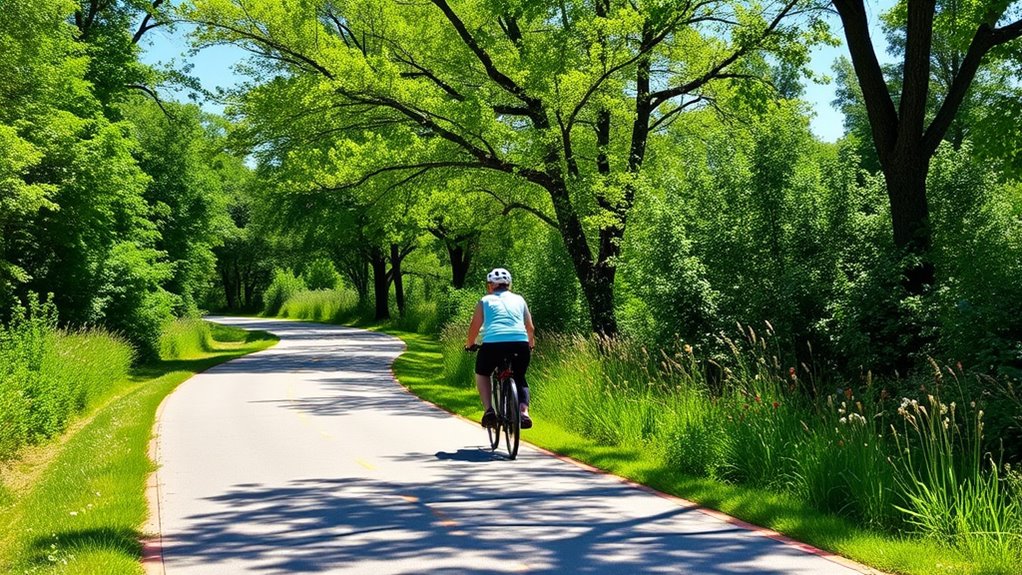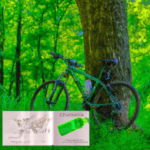To find safe, accessible cycling trails near you, look for routes with dedicated bike lanes, smooth surfaces, clear signage, and proper lighting. Cities like Portland, Minneapolis, and San Francisco lead with extensive, user-friendly bike infrastructure—space for all riders. Maintaining and evaluating trail safety is key, so seek out information on community-approved paths that prioritize inclusivity and good maintenance. Keep exploring, and you’ll discover tips to make your rides both safe and enjoyable.
Key Takeaways
- Choose well-maintained trails with clear signage, proper lighting, and smooth, stable surfaces for safe riding.
- Prioritize routes with dedicated, protected bike lanes separated from pedestrian paths to minimize conflicts.
- Check local safety and accessibility assessments, such as Level of Traffic Stress scores and hazard reports.
- Use trails that incorporate effective drainage and hazard management to prevent water accumulation and surface damage.
- Engage with community programs and local cycling groups to find recommended, safe, accessible routes.
Benefits of Accessible Cycling Infrastructure
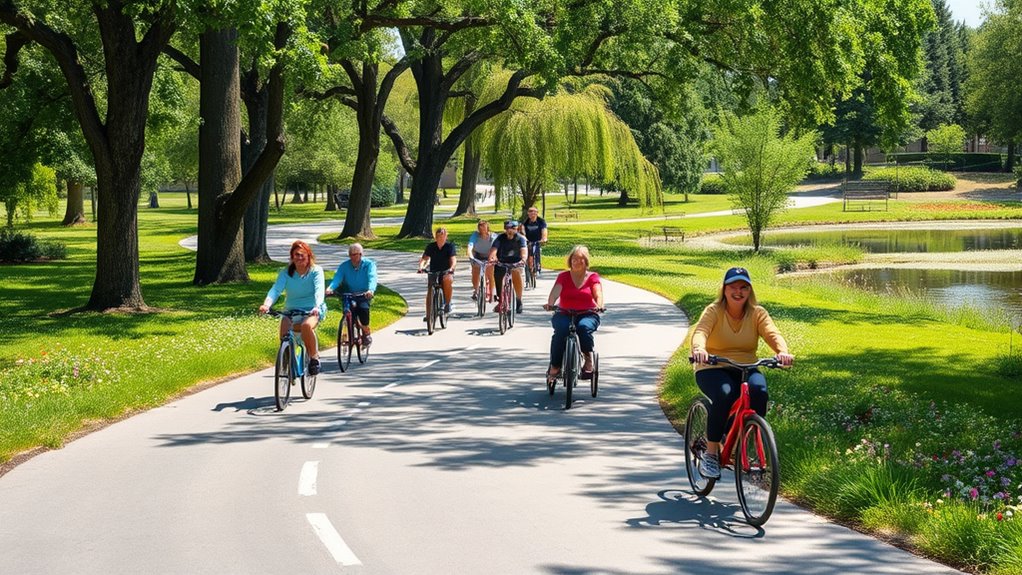
Accessible cycling infrastructure offers numerous benefits that positively impact individuals and communities alike. When you have safe, dedicated bike lanes, your physical health improves as regular cycling lowers the risk of chronic diseases and boosts mental well-being. It encourages healthier lifestyle choices and outdoor activity, leading to an overall better quality of life. Additionally, integrating cycling tuning features into urban planning can further optimize safety and performance for riders of all skill levels. Properly designed infrastructure also reduces the risk of accidents and enhances overall road safety, making cycling a more attractive option for more people. Incorporating water management strategies in cycling infrastructure can help prevent erosion and flooding, ensuring safer riding conditions during adverse weather. Implementing regional legal resources can support community efforts to develop safe cycling zones and improve infrastructure quality. Developing comprehensive urban planning strategies ensures that cycling infrastructure is effectively integrated into city layouts, maximizing benefits for users. Environmentally, cycling produces zero emissions, reducing pollution and helping improve urban air quality. It supports sustainability by decreasing reliance on fossil fuels and lowering your personal carbon footprint. Economically, bike-friendly areas attract visitors, increase local spending, and raise property values. Additionally, safe cycling infrastructure enhances road safety, reducing accidents and improving traffic flow.
Notable Cities Leading the Way
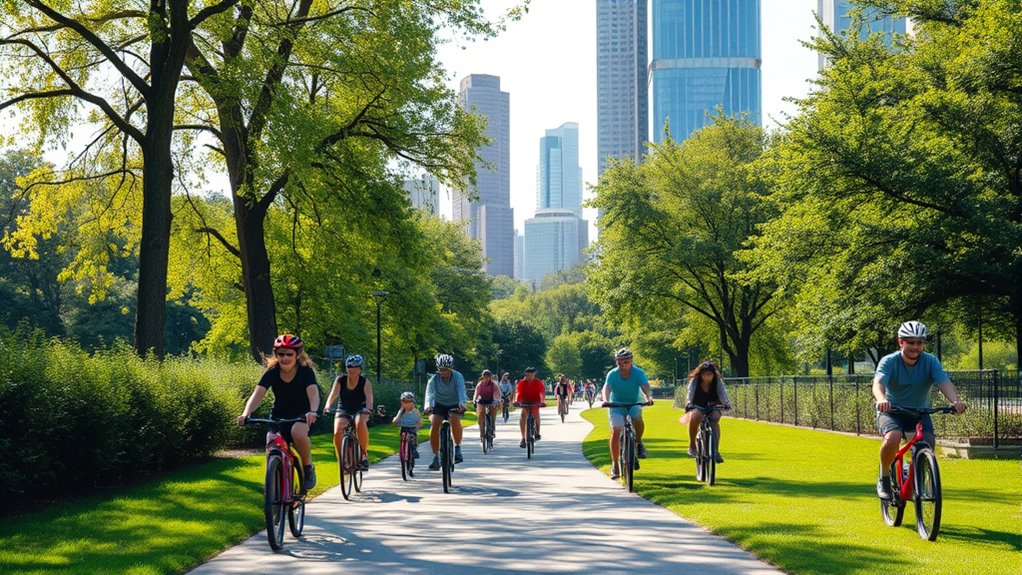
Cities around the world are setting the pace for bike-friendly development through innovative infrastructure and vibrant cycling cultures. Portland, Oregon, leads the US with extensive bike lanes and a strong cycling community.
Minneapolis boasts a high bikeability score, protected bike lanes, and 101 miles of off-street trails that make riding safe and accessible. San Francisco ranks highly for its cycling initiatives and infrastructure. Additionally, the integration of cycling safety measures plays a crucial role in encouraging more residents to choose biking as a primary mode of transportation. Implementing proper bike lane design significantly reduces accidents and enhances rider confidence.
New York City offers over 100 miles of Greenway paths and aims for 250 miles of protected lanes by 2026, hosting major events like the Five Boro Bike Tour.
Madison, Wisconsin, is quickly rising in bike-friendliness rankings, supported by advocacy groups and cycling programs. These cities demonstrate how strategic investments and community engagement foster safer, more inclusive cycling environments, including essential oils for safety and health, which can support cyclists’ well-being during rides.
Key Safety Features for Inclusive Trails
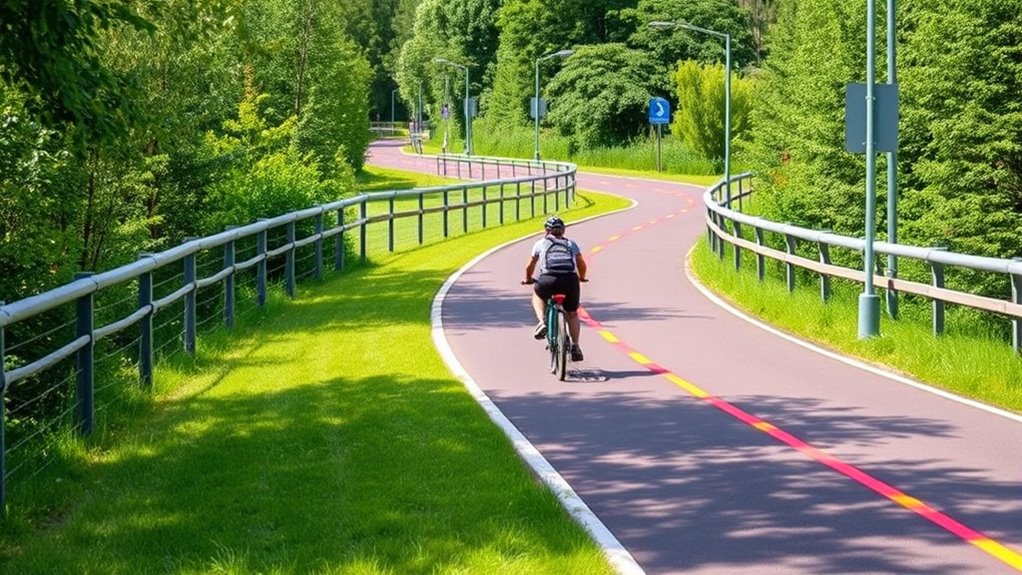
Creating safe and inclusive cycling trails requires careful attention to design features that accommodate all users. Start with a minimum width of 60 inches to ensure safe passing in both directions. A smooth surface reduces barriers for users with mobility impairments, including cyclists and pedestrians. Clear signage is essential to guide everyone effectively and prevent confusion. Incorporating innovative materials can further enhance trail durability and safety. Adequate lighting and good visibility boost safety during low-light conditions or at night. Implementing proper drainage systems helps prevent water accumulation and reduces slipperiness, enhancing safety during adverse weather. Ensuring compatibility with various headphone types can improve communication and safety for trail users who prefer listening to audio guides or music while riding. Additionally, implementing cybersecurity measures can protect trail management systems and user data from digital threats. Regular maintenance and speed limits further guarantee safety, making the trail welcoming for all. Incorporating advanced materials in trail construction can also help withstand weather-related wear and tear, prolonging usability and safety. Emergency access routes and contact information help respond quickly to incidents. Separating bike lanes from pedestrian paths minimizes accidents. Visual aids like tactile markers assist users with low vision, while wide shoulders provide space for rest stops without obstructing traffic.
Designing Trails for All Abilities
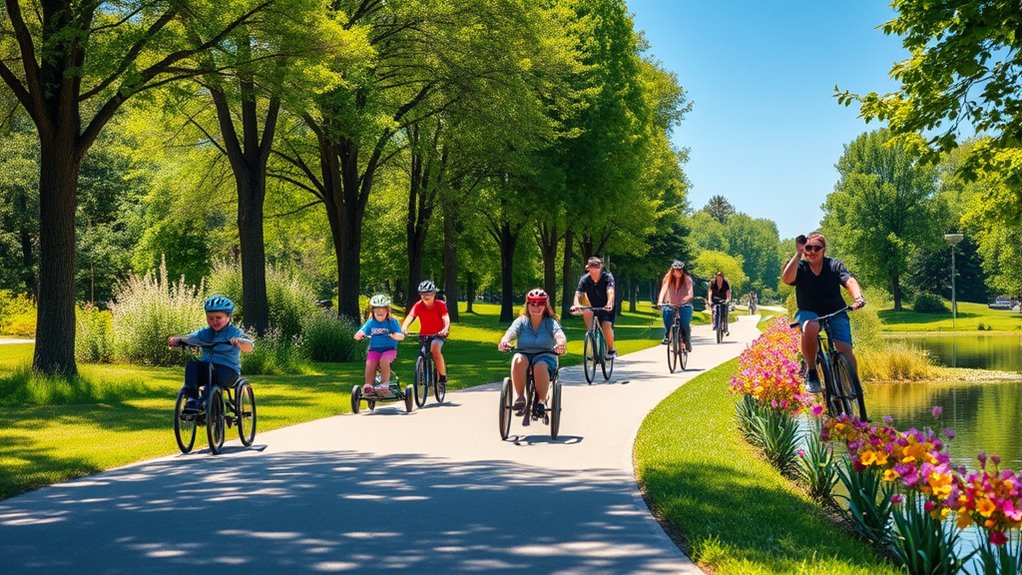
Designing trails for all abilities involves adhering to established legal standards and best practices that guarantee everyone can use and enjoy the space safely. You must follow ADA requirements, ensuring accessibility for people with mobility challenges, and incorporate PROWAG guidelines for shared-use paths.
Federally funded trails need to meet Architectural Barriers Act standards. Keep trail widths between 5 and 8 feet, with cross slopes of 2-5% to prevent wheelchair drift. Use firm, stable surfaces like asphalt or compacted materials, avoiding narrow shoulders and providing resting areas without obstructing traffic.
Seamless integration into natural surroundings is key, using native materials and subtle barriers to prevent veering. Prioritize accessible routes to key resources, balancing ecological preservation with user convenience. Additionally, incorporating wayfinding signage enhances navigation for all users, ensuring safety and accessibility throughout the trail. Ensuring that trail surface stability meets standards helps prevent accidents and makes the trail more accessible for all users.
Incorporating accessible design features can further improve safety and usability for diverse trail users, and considering trail surface maintenance ensures long-term accessibility and safety. Moreover, understanding local supermarket hours can help plan maintenance schedules to minimize disruption and enhance user experience.
Maintaining Safe and Usable Paths
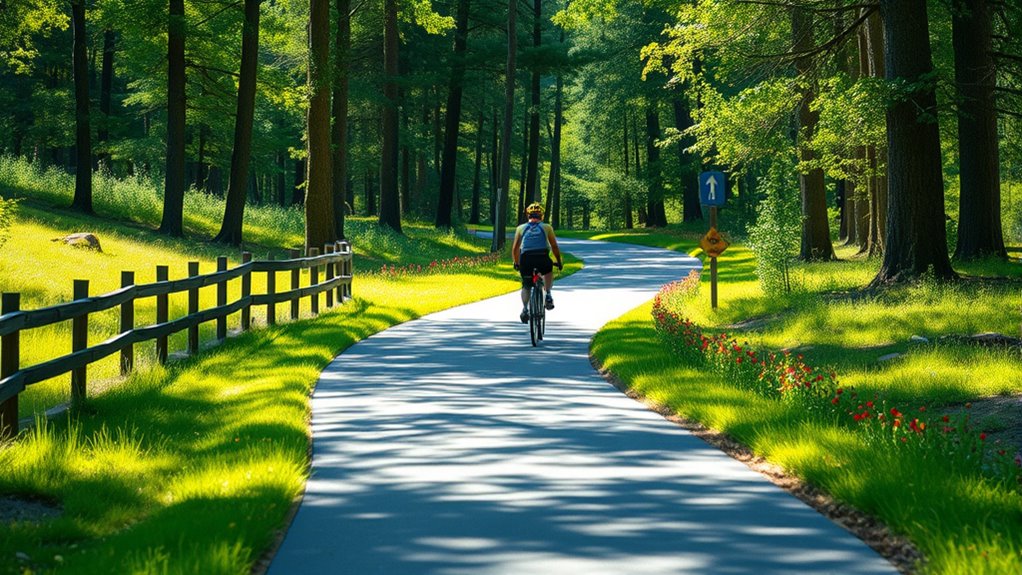
Regular maintenance is essential to keep cycling trails safe and functional for all users. You should respond quickly to hazards, addressing critical issues like drainage problems or surface defects within 48 hours. Conduct annual safety inspections on major paths to identify pavement issues, overgrowth, or drainage failures. Clear debris immediately after accidents, especially in high-traffic areas, to prevent further risks. After storms, remove sand, cinders, mud, and fallen branches promptly. Maintain trail surfaces by sealing cracks, grinding bumps, and managing roots to prevent accidents and erosion. Regularly trim vegetation, cut hazardous branches, and remove invasive plants to keep corridors clear. Implementing proper maintenance practices helps prolong trail lifespan and ensures user safety. Using systematic inspections and work orders to prioritize repairs, ensuring your trails stay safe, accessible, and well-maintained year-round. Incorporating remote monitoring tools can further enhance the efficiency of maintenance efforts and early hazard detection. Additionally, applying proper drainage management techniques can significantly reduce water accumulation and related damage on the trails.
Promoting Awareness and Community Involvement
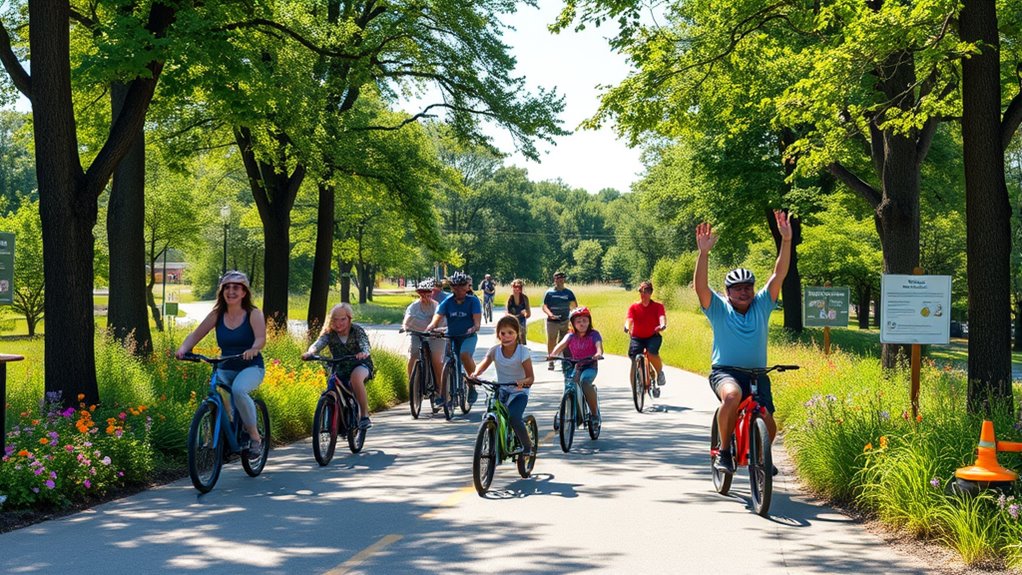
How can communities effectively raise awareness and foster involvement around cycling trails? You can organize monthly community bike rides to draw in new riders and build social bonds. Developing field ambassador programs allows for personal outreach, making newcomers feel welcome. Hosting inclusive events like adaptive cycling clinics ensures everyone, regardless of ability, can participate.
Setting up tabling at local gatherings helps recruit volunteers and spreads trail advocacy messages. Partnering with schools to incorporate cycling education engages youth and families. Using public awareness campaigns highlights trail features and benefits for marginalized groups.
Leveraging social media shares user stories, maps, and safety tips, broadening reach. Distributing multilingual materials ensures non-English speakers feel included. These strategies create a vibrant, informed community invested in accessible cycling.
Evaluating Infrastructure Success
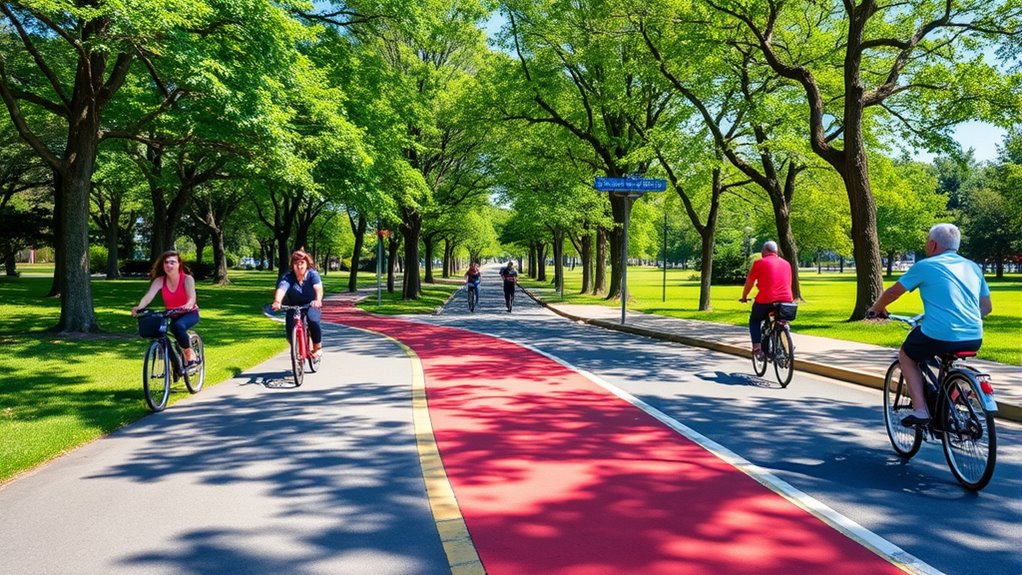
Evaluating the success of cycling infrastructure is essential to guarantee it meets community needs and promotes safety. You should analyze safety metrics like Level of Traffic Stress (LTS) scores, with lower levels indicating safer routes for all riders, and monitor illegal parking density in bike lanes to ensure unobstructed access.
Gravity-based accessibility metrics help measure how well cycling connects you to essential destinations like work or stores. Route modeling simulates how easily you can reach these places, while bike lane monitoring detects obstructions or misuse.
Equity and accessibility assessments reveal if infrastructure serves marginalized communities, ensuring wider participation. Regular maintenance, effective intersection treatments, and clear wayfinding systems further enhance safety and usability, confirming that the cycling network truly supports safe, equitable riding for everyone.
Funding and Supporting Cycling Projects
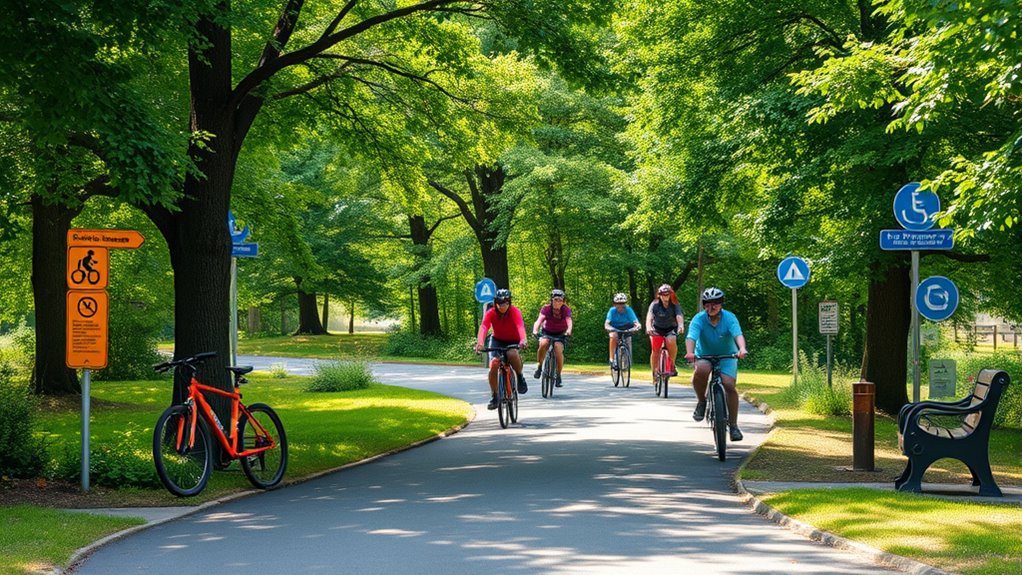
Securing funding is crucial to developing and maintaining effective cycling projects, and a variety of sources support these efforts. Federal programs like the FAST Act’s Highway Safety Improvement Program and the Bipartisan Infrastructure Law provide dedicated funds for bike infrastructure and active transportation networks. The Transportation Alternatives program supports trail development and bike projects, while DOT’s Discretionary Grants Dashboard helps you find funding opportunities tailored to your project.
State-level programs, such as California’s Active Transportation Program, allocate substantial annual funds specifically for biking and walking projects.
Local governments can tap into municipal funds, developer fees, and special tax districts, with some communities leveraging park bond funding.
Non-government sources, including industry grants, corporate sponsorships, and crowdfunding, also play an essential role in supporting cycling initiatives.
Enhancing Safety With Signage and Lighting

Enhancing safety on cycling trails relies heavily on effective signage and lighting, which guide users and prevent accidents. Clear markings on multi-use paths help you stay in your lane and avoid conflicts with pedestrians. Directional signs inform you of trail layout and connections, while speed limit signs encourage safe riding speeds, especially near pedestrian zones.
Hazard warning signs alert you to obstacles ahead, reducing the risk of crashes. Emergency information, like maps and contact details, can be lifesavers if needed. Proper lighting, such as solar-powered or adaptive systems, guarantees good visibility during evening rides, making you more visible to others and helping you see potential hazards.
Well-placed signage and reliable lighting work together to create a safer, more confident cycling experience.
How to Find Safe Cycling Routes Near You
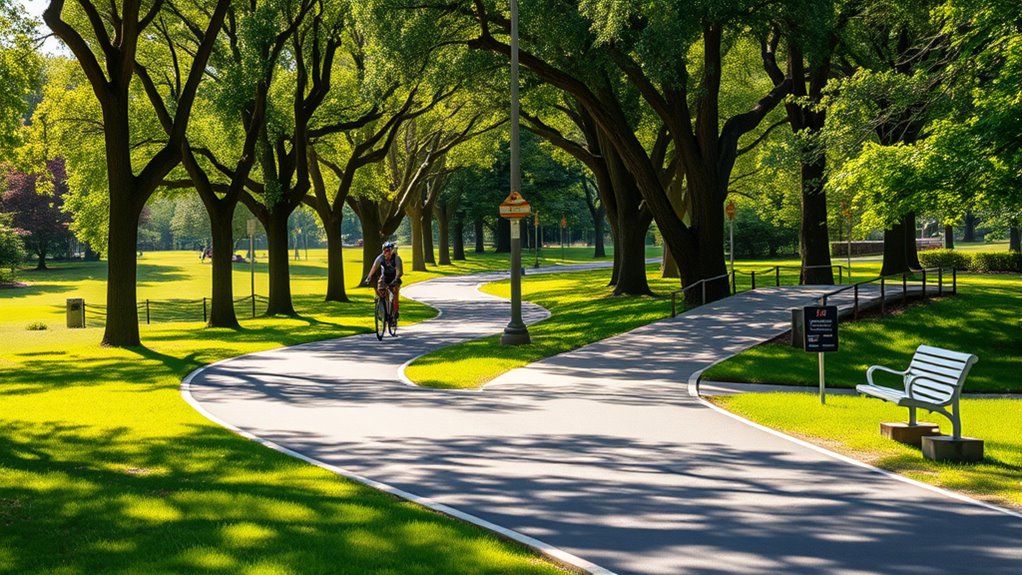
Finding safe cycling routes near you starts with exploring local trail networks and online resources. Check out municipal trail maps, parks, and nature reserves, which often feature dedicated cycling paths. Websites like Bike Tennessee and community forums can provide valuable route suggestions and safety tips.
Use route planning apps such as Ride with GPS or Bikemap to visualize paths and get detailed directions, reviews, and traffic alerts. Assess road safety features by looking for low-traffic roads, bike lanes, good lighting, and smooth pavement.
Consider terrain and weather conditions to avoid hazards. Engaging with local cycling clubs and attending group rides helps you learn about safe routes firsthand. Online groups and events are also excellent sources for discovering new, secure cycling paths near you.
Frequently Asked Questions
How Do I Identify Truly Accessible Cycling Trails in My Area?
You want to find truly accessible cycling trails nearby. Start by checking the TrailLink database or biking apps for filtered options with accessibility features.
Contact local parks or visit government websites for detailed trail info.
Use user reviews and community feedback to gauge safety and condition.
Look for trails with smooth surfaces, proper signage, and minimal slopes.
These steps help guarantee you pick safe, inclusive routes that suit your needs.
What Accommodations Are Available for Cyclists With Disabilities?
Imagine your ride as a journey through a tailored landscape, where every detail is crafted for your comfort. Accommodations like smooth, wide trails with gentle slopes act as welcoming pathways.
You’ll find adaptive bikes, hand cycles, and tandem options that turn obstacles into opportunities. Rest areas serve as safe harbors, and support programs guide your ride.
These thoughtful features guarantee your cycling experience is as smooth and empowering as possible.
Are There Specific Safety Tips for Riding on Protected Bike Lanes?
When riding on protected bike lanes, you should stay alert and follow safety tips. Keep your handlebars centered and avoid hugging barriers to maintain good visibility. Use hand signals clearly to communicate your intentions.
Watch for vehicles turning at intersections with protected phases, and stay within the marked lane. Limit your speed to 15 mph or less, especially in shared spaces, and always be aware of your surroundings for a safe ride.
How Can I Contribute to Improving Local Cycling Infrastructure?
You can improve local cycling infrastructure by joining advocacy groups and participating in public consultations. Push for protected bike lanes, road diets, and green wave signals.
Use data tools to identify unsafe routes and support measures like bike parking and multimodal access. Collaborate with nonprofits and policymakers to secure funding, pilot projects, and implement Complete Streets policies.
Your active involvement helps create safer, more connected cycling environments for everyone.
What Resources Are Available for Learning About Accessible Cycling Opportunities?
You can explore various resources to learn about accessible cycling opportunities. Use the TrailLink app or website to find trails filtered by accessibility features.
Check local parks and state guides for maps and trail details. Join biking communities online for tips and advice.
Contact park authorities directly for specific questions. Additionally, organizations like Rails-to-Trails Conservancy and Adventure Cycling offer valuable info, maps, and training to help you find suitable routes.
Conclusion
By prioritizing accessible cycling trails, you’re opening doors to safe, inclusive adventures—like a well-lit path guiding you through the dark. With thoughtful design, proper maintenance, and clear signage, you can enjoy cycling experiences that are as smooth as a well-paved road. So, explore your local trails confidently, knowing that safe, accessible routes are within your reach. Together, we can make cycling safer and more enjoyable for everyone, no matter their ability.
